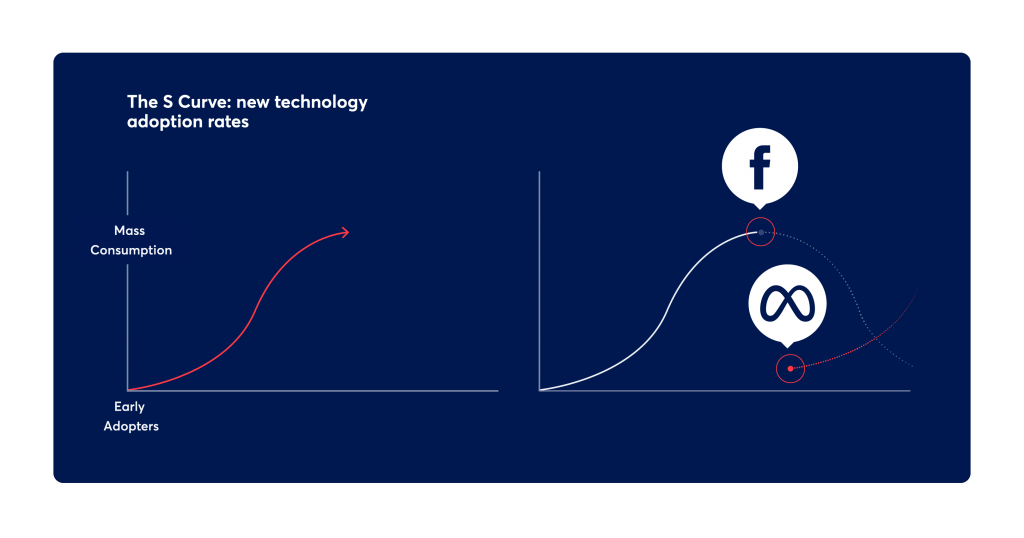By: McCrindle
Mark Zuckerberg recently announced the arrival of ‘Meta’ – a parent company that will house the stable of products and companies owned by the tech giant to allow autonomy between each product under a larger, purposeful banner.
This isn’t unusual in a corporate sense – Google famously developed and put itself under ‘Alphabet’1 to allow their significant stable of companies to coexist incorporate horizontal integration. Unlike Alphabet, the naming convention was to provide a statement on the ushering of Zuckerberg’s biggest aspiration – the ‘Metaverse’: a virtual reality world that they describe as the “next evolution of social connection” using 3D spaces to “socialise, learn, collaborate and play.” 2
This is a long play, a big bet on a moonshot vision that Zuckerberg has been cooking for a while. In 2014, Facebook acquired virtual reality headset manufacturer Oculus for $2 Billion.3 Furthermore, ‘Facebook Reality Labs’, a new entry spun out of Facebook itself and firmly planted within the Meta umbrella, has a workforce of 10,000 strong – indicating a clear prerogative to win the Virtual Reality race.4
It sets the foundations of the beginnings of the “next big thing in innovation”, positioning itself well into the beginning of the life cycle of technological innovation. As Ben Evans, a technology analyst put it, “Personal computers, the internet and mobile phones emerged, grew and matured in waves – from a “silly idea” to something everybody has a platform to build on and further evolve the next innovation”.5
These waves of innovation, seen below, can take place over time. As one innovation matures, another accelerates rapidly.

So, what could this Metaverse look like? We look at two major pillars of seemingly disparate entities – social gaming and payments and understand just how intertwined they are, and how Generation Alpha, who could be the beta testers of Meta – could shape the existence of the Metaverse.
 Blurred lines: social network and a game
Blurred lines: social network and a game
Gone are the days where kids plug a console in front of a TV and play Mario Kart with their friends in the living room. Video gaming is inherently social and boundaryless.
Virtual social spaces are, in principle, not new. World of Warcraft, released nearly 20 years ago is a massively multiplayer online role-playing game that allows players to enter a virtual fantasy world as an avatar to meet with other players across the world, defeat monsters, find loot and earn currency. At its peak, there were 12 million players in 2010.6
As online gaming evolves, the needs to create confined objectives change too. Recently, the hit video game Fortnite hosted a “virtual concert’ within its game world. More than 12.3 players viewed this concurrently.7 This blurs the line between what is traditionally done in a video game with set objectives (working together to beat an objective to earn rewards), to a casual space with an undefined objective (hang out, listen to music), while identifying the demand of virtual online spaces – or a social hub for Gen Z, it’s largest current cohort of players.
Roblox and Minecraft are also two examples of popular video games that do not conform to the traditional objective-led play that most video games follow. Rather, they allow experimentation, creativity and most importantly, unplanned social interaction.
Furthermore, Pokemon Go (an augmented reality game that simulates the virtual world of the popular franchise through a player’s mobile phone camera) captured the imaginations of the same demographic. Remarkably, it is still one of the most popular mobile apps, despite being five years old.
Zuckerberg expects the Metaverse to reach a billion people within the next decade. While currently there is an all-encompassing aspiration for people to “socialise, learn, collaborate and play”, there is every likelihood that the “play” could be the lowest hanging fruit. This is because existing use cases of successful social networking platforms within “traditional” video games and augmented reality gaming are proof of concept. Furthermore, it is already embedded in the minds and behaviours of our future teen generation – the current Generation Alphas.
 A one-stop shop
A one-stop shop
An interesting arm in the Meta stable is the Calibra Digital Wallet (formerly Libra) & Diem network – a cryptocurrency payment product powered by the blockchain to help people access “safe and affordable financial services”. This too is still in its infancy with no usable product at current.
The premise of a blockchain network for this is simple: instead of an intermediary (such as a bank or an accountant) keeping track of a customer’s monetary transactions, it uses a decentralised network to allow all users to record every transaction, removing the need for an intermediary. Cryptocurrency (such as Bitcoin) is built on the back of the blockchain network and is the main asset for use.
Currently, people use cryptocurrency in a similar way to stocks. Already, 16% of adults in the United States have reported having owned or traded cryptocurrency in the last year.8 While it has existed for the better part of the decade, it has exploded in popularity over the last few years in value. At one point, all cryptocurrencies were as high as $2.8 trillion USD as of December this year.9 Furthermore, its form and usage have evolved too.

The use of cryptocurrency has moved to an unlikely industry – the art world. The development of non-fungible tokens (NFTs) allows individual pieces of data (in most cases image files) to be “minted” into a blockchain network, creating exclusivity in commonly shareable files. The most common use is for digital artists to create exclusivity in their work and derive value from said exclusivity.
 Completing the ecosystem
Completing the ecosystem
Akin to how many non-western social platforms operate, a digital wallet within a social network allows seamless payments without the user ever leaving the ecosystem. For example, WeChat, China’s largest mobile app with over a billion users, is an “app for everything”. It is a social network, text messaging, video conferencing and video games platform. WeChat uses the native WeChat Pay as a frictionless layer to manage payments within the app.
A virtual reality world is a high stakes game when it comes to immersion. Ultimately, Zuckerberg requires users to be immersed into the Metaverse the way a master magician captivates the audience before the big reveal.
Cryptocurrency offers the next layer of sophistication in digital payments, and in the case of Facebook, or Meta, allowing full control over the payment ecosystem. This could mean that not only will Meta be able to free itself from the reliance on banks or payment gateways like Paypal, but it will be able to develop and control its own currency in its virtual world.
Most importantly, a blockchain-based network allows an organic development of supply and demand where limits are created based on the availability of goods, just like in real life. Like how NFTs are creating exclusivity and rarity over digital images through supply and demand, Meta can apply this concept within their own virtual world, and with virtual assets. A self-sustaining economy that has no ties to “the real world” could be the immersive layer that creates a separation between “Metaverse” possessions and that of the real world.
Younger generations are used to converting fiat currency into “in-game currency” to purchase things in virtual worlds. This type of behaviour – where people purchase something to complement their Metaverse avatar – could very well be the norm in a decade’s time.
There are many more elements that need to be considered for the S curve of the Metaverse to form. Another consideration is ways Meta could cover hardware and software limitations – a problem they have been trying to solve for nearly a decade now. However, the implications could be the same. The first movers of the Metaverse just might be Generation Alpha – the most technologically integrated generation of our lifetime.
The question is, as Mark Zuckerberg’s roadmap and offerings become clearer over the next decade, will this product become a market fit for the most sophisticated generation of kids (and soon to be teenagers) to come?
1https://abc.xyz/
2https://about.fb.com/news/2021/10/facebook-company-is-now-meta/
3https://techcrunch.com/2014/07/21/facebooks-acquisition-of-oculus-closes-now-official/
4https://www.theverge.com/2021/3/12/22326875/facebook-reality-labs-ar-vr-headcount-report
5https://www.ben-evans.com/presentations
6https://techland.time.com/2013/05/09/the-inexorable-decline-of-world-of-warcraft/
7https://www.polygon.com/fortnite/2020/4/24/21235017/fortnite-travis-scott-event-concert-astronomical-12-3-million-concurrent-players-record
8https://www.pewresearch.org/fact-tank/2021/11/11/16-of-americans-say-they-have-ever-invested-in-traded-or-used-cryptocurrency/
9https://coinmarketcap.com/all/views/all/
Article supplied with thanks to McCrindle.
About the Author: McCrindle are a team of researchers and communications specialists who discover insights, and tell the story of Australians – what we do, and who we are.
Feature image: Photo by Jessica Lewis on Unsplash

 Blurred lines: social network and a game
Blurred lines: social network and a game A one-stop shop
A one-stop shop Completing the ecosystem
Completing the ecosystem